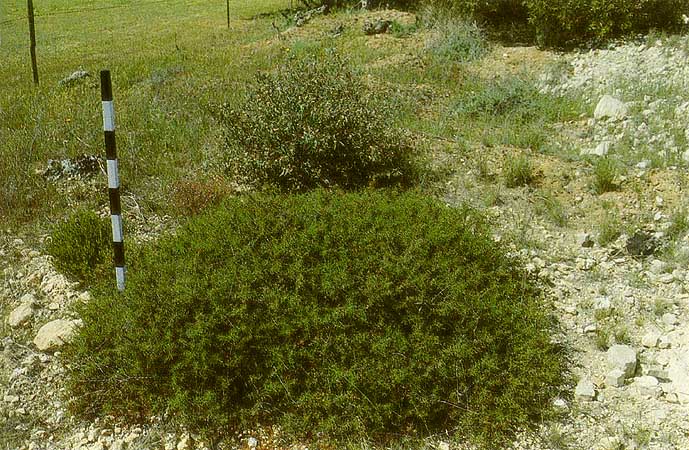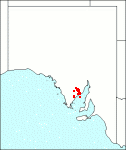Family: Fabaceae
Acacia hexaneura

Citation:
P. Lang & R. Cowan, J. Adelaide Bot. Gard. 13:115-118 (1990)
Derivation: hexa (Gr.)—six; neuron (Gr.)—a nerve, refers to the six veins on the phyllodes.
Synonymy: Not Applicable Common name: None
Description:
A rigid, prickly roughly rounded shrub rarely over 1 m high, to 2 m wide. Branchlets angular, ribbed when young, pubescent with minute antrorse hairs plus some short stout hairs on a pustular base, sometimes slightly resinous. Stipules persistent, spinose, straight or slightly recurved, to 1.5 mm long, with a thickened flange surrounding base of phyllode.
Phyllodes sessile, perpendicular, rigid, straight or slightly recurved, compressed, 5-17 (-23) mm long, 1-2 mm wide, distinctly 6-veined (one on each margin and two on each face) with veins strongly raised in well defined ridges, abruptly tapered into a rigid mucro 1-2 mm long, base swollen and articulate; pulvinus reduced; gland in a slot at the base of the upper vein.
Inflorescence simple, axillary. Peduncles 1 rarely 2 per node, 5-7 mm long, minutely appressed pubescent. Flower-heads globular, 16-20-flowered, golden-yellow, 4-6 mm diam. Flowers 5-merous.
Legumes often persisting as a tangled mass, linear, undulate and irregularly bent or folded 3.5-9.0 cm long, 2-3 mm wide, sparsely pubescent towards base, slightly raised over seeds, scarcely constricted. Seeds longitudinal 2.5-3.5 mm long, 1.5-2 mm wide, aril apical, white ~3-2/3 length of seed; funicle small, filiform.
|
|
Distribution:
|
Confined to north-eastern Eyre Peninsula between Kimba and Cowell. Found on well drained gravelly loams and sands, on small quartzite hills with associated limestone or ironstone deposits. In plant communities with Eucalyptus dumosa-E, gracilis, Melaleuca uncinata and a sclerophyllous shrub understorey.
S.Aust.: EP.
|
Conservation status:
Lang considers this species relatively secure, as two small populations are conserved in a Heritage Agreement area. Lang rates it as Rare but Conserved.
Flowering time: July to September, and in fruit November to January.
|

SA Distribution Map based
on current data relating to
specimens held in the
State Herbarium of South Australia
|
Biology:
No text
Taxonomic notes:
A distinctive species related to A. enterocarpa (species 75) from which it differs in its shorter phyllodes, fewer veins, fewer peduncles per node, and legumes not folded in a single plane (jumping jack form). Superficially A. rhigiophylla may be confused with A. hexaneura but the former has more veins, flower-heads cylindrical with fewer 4-merous flowers, legumes curved and not undulate, seed with a yellow aril. A. colletioides and A. nyssophylla can be distinguished by their caducous stipules, and phyllodes 8- and 16- (or more)-veined. They also have a prominent yellow or orange aril.
Cultivation:
No records of the species in cultivation but it could provide an intricate, pungent, moderate sized, free flowering shrub for well drained drier sites.
Author:
Not yet available
Source:

|

